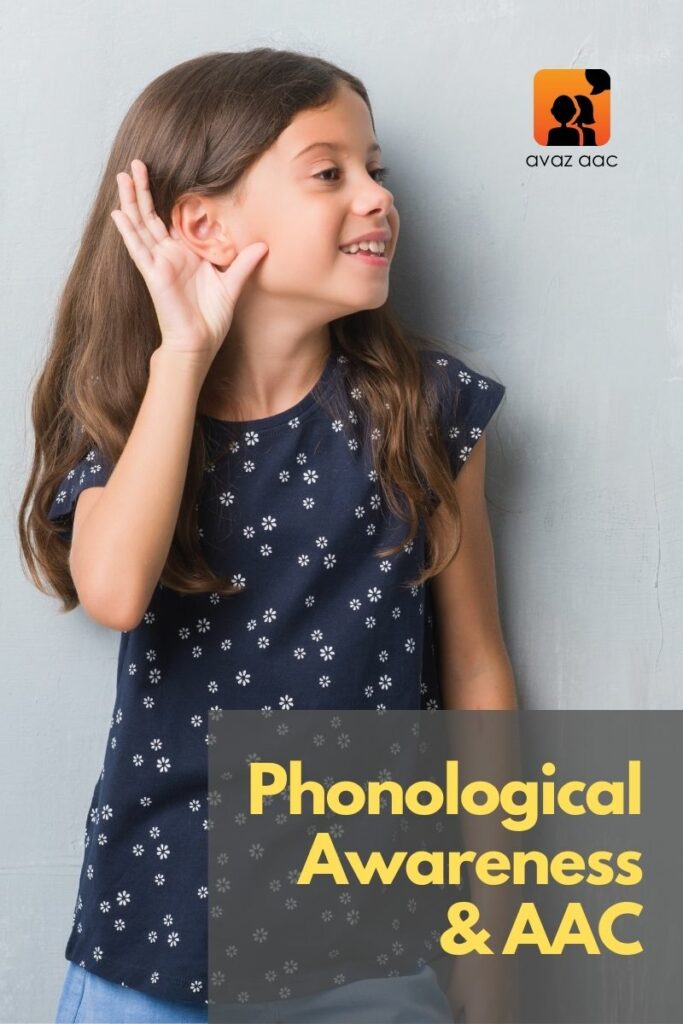Literacy is significantly about reading, writing and social interaction. Thanks to research, we now know that a lot more goes into developing early literacy. A child’s capacity to recognize sounds and words is key. Children with disabilities develop literacy skills with assistance and this is where AAC comes into play. In this blog, we will look at Phonological Awareness, one of the most important aspects of emergent literacy. We will also see how AAC can help with its development.


What is Phonological Awareness?
Phonological awareness is an important aspect of learning to read. It is the capacity to understand and modulate sounds in spoken language. Some children learn it naturally, while others require further assistance.
A child with phonological awareness understands letter sounds but may face difficulties trying to blend the sounds to form a whole word.
Reading requires phonological awareness since written words match our spoken words. In order to shift from a printed word to a spoken word or vice versa, readers must be aware of the speech sounds that letters and letter combinations represent (Moats, 2010)
In case of non-speaking individuals, they don’t get to practice learning to manipulate, isolate and delete sounds. Their phonological awareness tends to develop later, as they learn to read. Comprehensive literacy instruction will help them develop phonological awareness.
5 stages of Phonological Awareness
Stage 1 :
Rhyming & Alliteration – Both rhyming and alliteration share a common or sound. Rhyme involves paying attention to the last sound of a word, whereas alliteration requires paying attention to the first. For example, Hickory Dickory dock, the mouse ran up the clock. Children associate the rhyme with the last word. Meanwhile an example of alliteration could be Big Brown Bear where children associate with the first word.
Stage 2:
Sentence Segmentation – Learning to separate words in a sentence help children understand how to put it together to make up a sentence. This not only improves understanding of a word’s power, but it’s also a fun method to practice semantics (the meaning of a word)
Stage 3:
Syllables – Every word can be broken into syllables. At this stage, children need to understand the process of segmenting syllables. For example, Table has two parts being ta-ble.
Stage 4:
Onset & Rimes – We can break words down into smaller bits to help children think about words as sound. The onset (everything before the vowel) and rime (everything after the vowel) are two ways to break down the syllable (the vowel and everything after it). Sleep, for example, may be separated into /sl/ and /eep/.
Stage 5:
Phonemic Awareness – Phonemic awareness is a subset of phonological awareness in which listeners are able to hear, identify and manipulate phonemes. Phonemes are smallest unit of sound in speech. For example, the word cat has 3 phonemes, c/a/t.
Children can express phonemic awareness in a variety of ways, including:
- Identifying which words in a group start with the same sound (“Bell, bird, and boy all start with /b/.”)
- Isolating and saying the first or last sound in a word (“The first sound in the word jog is /j/.” “The last sound in the word fit is /t/.”)
- To speak a word, combine or blend the different sounds in the word (“/t/, /a/, /p/ – tap.”)
- Separating a word into its individual sounds (“no – /n/, /o/.”)
Phonological Awareness and AAC
Phonological awareness can be developed by AAC users, and they should be included in emergent literacy practice. Participating in shared storybook reading, introducing literacy themes into play, and engaging in vocal wordplay such as rhyming are all examples of emerging literacy activities. Phonological awareness has a different aspect when it comes to AAC users.
AAC users who who repeatedly press the same button, aren’t simply pressing the button. They’re listening to each sound in the word; they’re looking at the letters on the sentence bar; and they’re deleting letters here and there and hitting the sentence bar again to hear how it affects the word’s sound. Through this method, they navigate easily to the desired word when using the AAC device. For example: a child pressing the word “play” will navigate many pages and identify the word play next to any word. Providing the learners with AAC and sufficient vocabulary gives them freedom and space to explore a wide range of vocabulary and learn on their own.
On a Final Note
It is key to remember that phonological skills are not developed through exposure. Constant practise will allow the individual to develop these skills. Click here for more information on phonological awareness activities and other literacy skill activities.



